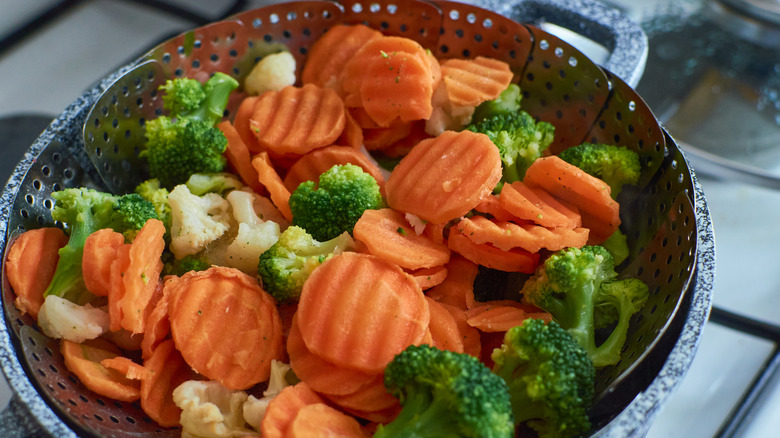The Steaming Mistake You're Probably Making
Steaming vegetables is a great way to cook them while preserving their nutritional value. According to a 2009 study published in the Journal of Zhejiang University, steaming results in the least nutrient loss of any vegetable-cooking method (via CNN). The study pitted steaming against other common cooking methods, including boiling, stir-frying, and even microwaving.
As Bon Appétit puts it, "steam is hotter than water," so it'll cook your veggies quickly. And unlike with boiling, the nutrients don't leach out into the cooking water. (There's simply nowhere for them to go.)
Plus, you can have fun with your steamer by adding aromatics, such as fresh ginger, sprigs of rosemary, or other fresh herbs, or whole heads of garlic, per The Seattle Times. And with careful timing, you can make an entire meal in your steamer. You don't have to get as fancy as a flavorful steamed crab leg recipe; you can cook simple eggs in your steamer right alongside your veggies.
Elevate your steaming, literally
There are a few tips you can follow to elevate your steaming action. It might seem like the more water you add, the faster things will go, but don't get ahead of yourself. You want there to be a few inches of space between the water level and the bottom of your basket or bamboo steamer (per Today). Letting your food touch the water is a common steaming mistake; Epicurious suggests using just an inch of water for vegetable steaming.
You'll also want to make sure your pot is fitted with a tight lid, or you'll be waiting forever for your food to cook, notes The Seattle Times. And if you're trying to sauté while you steam, put a small amount of liquid in the bottom of the pan. You want to be sure you have enough liquid to create steam when the lid's tightly closed.
Another way you can max out the flavor of your steamed veggies, fish, or dumplings is to add (or substitute entirely) broth, wine, soy sauce, or juice, imbuing your food with flavorful steam (per The Kitchn).

